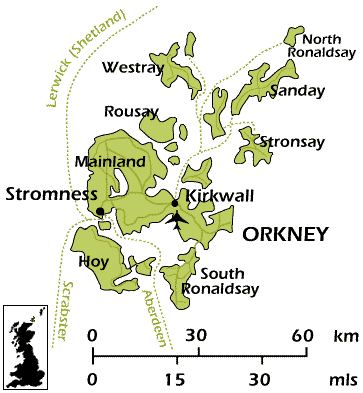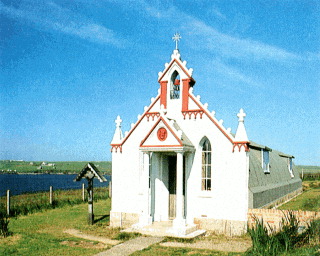


 |
|
The Italian Chapel stands today as a visible reminder of Lamb Holm's Camp 60 (Picture Craig Taylor) |
Standing alone on the little island of Lamb Holm watched over by a statue of St George slaying the dragon stands what is now known throughout the world as, simply, the Italian Chapel.
It is the only visible reminder that this was once the site of Camp 60 the prisoner-of-war camp where hundreds of Italians were housed while they worked on the nearby Churchill Barriers more than 40 years ago.
It is also a remarkable example of how a faith can survive in the adversity of war, and it stands today as a symbol of peace and reconciliation after those years of conflict in World War Two.
This year marks the 60th anniversary of the arrival of the Italian POWs in Orkney an event which is being marked by a special exhibition in the Stromness Museum.
In January 1942, 1,200 prisoners disembarked on the county's shores to work on the construction of the Churchill Barriers, the causeways that link the South Isles of South Ronaldsay and Burray to the Orkney Mainland.
They were at first defiant and hostile to their captors, while the Orcadians were afraid of
their new neighbours. This attitude was soon to change, and when most of them left
Orkney in 1944 there were tears shed on both sides.
The Italians left behind them more than just memories.
The Italian Chapel on Lamb Holm was built with loving care and devotion by the prisoners
and has continued to be loved and cherished by the people of Orkney. Some of the Italian POWs have returned to Orkney to renew old friendships and to make new friends.They are no longer "the enemy" nor were they when they left Orkney all those years ago.
Each year, thousands of visitors from throughout the world make the pilgrimage to see the chapel's astonishing beauty. Few can believe it is based on a basic Nissen hut enhanced
only by items of apparently worthless scrap.
The man who must take the lion's share of the credit was an Italian prisoner Domenico Chiocchetti, an artist and sculptor.
On his arrival, he and his fellow prisoners were put ashore in small boats because the steamer was too big to dock at the newly built Warebanks Pier in Burray. They were taken to Camp 34 on Burray, where they were all initially held.
A few days later 500 prisoners were taken to the small island of Lamb Holm where Camp
60 was to be their new home.Orkney in January could not have been more different from the climate in North Africa, as Signor Chiocchetti remembered.
The rock core of Number Two Barrier in place across Skerry Sound, linking Lamb Holm with Glimps Holm. The blockship in the foreground is the Lycia which provided a source of fish for the POWs. Fish became stranded in the hull of the vessel during receding tides. (Picture Orkney Library Archives) The little island (Lamb Holm) could hardly have appeared more desolate bare, foggy, exposed to the wind and heavy rain. The camp consisted of thirteen dark, empty huts, and mud.
Some of thev POWs were very defiant on their arrival, singing patriotic songs and shouting their support for Mussolini: Viva il Duce! Viva il Camerati!
Bright red target discs, 12 inches in diameter, were sewn onto the backs of the prisoners jackets, with two smaller targets over a leg and arm. They covered holes in the clothing, which prevented their removal.
When the POWs found that they were expected to work
on building the barriers they refused and went on strike. The leaders of the two camps explained that they were being ordered to carry out works of a warlike nature while their close proximity to a naval base put them in danger, both contrary to the Geneva Convention.Both leaders demanded the prisoners be moved to a
safe camp where no warlike work was being carried out.
The authorities refused, and both camps went on strike. They were put on a 14 day punishment diet of bread and water, with normal rations every four days.The problem was resolved when a new camp Commander, Major T. P. Buckland, was appointed to Lamb Holm. He could speak Italian, and soon had the trust of the prisoners.
He organised a meeting with the camp leaders and the Kirkwall Provost P. C. Flett, who assured them that they were building causeways that would link these islands with the Mainland, bringing great benefits to the local people. This was accepted, and work resumed. The camp leaders and a few others were blamed for the trouble and removed to other camps.
The sinking of the battleship HMS Royal Oak by the German Submarine U-47 on October 14, 1939 with the loss of 833 lives prompted Winston Churchill to order the permanent closure of the four channels at the east end of Scapa Flow.
A mountain of concrete blocks at the Holm Blockyard of Kirk Sound Great barriers that would carry the wartime leader's name were planned to close these gaps. Balfour Beatty & Co. Ltd began work in 1940, building work camps, piers on the uninhabited islands of Lamb Holm and Glimps Holm, railway lines, power stations, and the erection of huge cableways, called blondins, to carry the rocks and concrete blocks over the seas between the islands.
Wire nets were placed inside a metal box which was then filled with stones. The nets, called bolsters, were taken to the cableway and hoisted over the sea and tipped out. This process was repeated many tens of thousands of times until a solid wall of rock was formed. Concrete blocks were placed over the rock core to protect it from the elements. The blocks were arranged pell - mell over the sides to help to break up the pounding waves.
The routine of camp life was very much like normal army life, with Reveille at 6 am in summertime and at first light in winter. Lights out was at 10 pm. An extra roll-call was sometimes held after work, just to keep the prisoners on their toes, when British money and any weapons were confiscated. The prisoners were paid in camp money, tokens that could be exchanged in the camp canteen.
The prisoners used music and theatre to lift their spirits during their captivity. Camp bands were formed to play popular tunes from home. Among the prisoners were two artists, one was sent to each camp. Domenico Chiocchetti was sent to camp 60 on Lamb Holm where he designed and painted theatrical props.
An operetta, The Baker of Venice, was performed, complete with moving gondolas. Friends were invited, including the landowner P. N. Sutherland Graeme and his family who lived at Graemeshall on the other side of Kirk Sound. They brought with them a bunch of flowers from the garden, which was used in every scene.
The home made theatre was overlooked by paintings of the Italian King Umberto and his queen (Picture Orkney Library Archives) Camp 34 on Burray staged an elaborate production, with scenery made to represent
a three - storey Palazzo. To give an
impression of height it had windows at the
top that the singers popped their heads
through.Both camps had good football teams, and
after the Capitulation a sports day was
organised in Camp 60, with members from Burray's Camp 34 invited.
The prisoners also made a bowling alley out of concrete, as well as a concrete billiards table, complete with concrete balls. The cushions were made of army blankets.
But despite the sport, music and theatre that the prisoners enjoyed, many wanted a church.
In a POW camp life can be a dull daily routine not always improved by billiards, table-tennis, football or amateur theatre, all things that we POWs had the strength to keep going. That wasn't enough, not for most of us at least, recalled POW Bruno Volpi.
Nights were our worst enemy. Long nights when thoughts went back home to those we loved. Bad news from home, that somehow reached us, was the cause of deep depression that no entertainment could ease. Only thinking of something more nobler, more elevated, could we find inner peace and hope. So the tiny chapel came gradually into existence.
-End of Part 1-